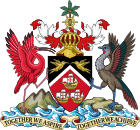User:Guettarda/Sandbox 44
 |
|---|
|
|
Trinidad and Tobago became independent on August 31 1962. Following the collapse of the West Indies Federation the government sought to pursue independence alone. While the country initially retained the British monarch as head of state, with the adoption of a new constitution in 1976 it became a republic.
History
[edit]Between 1797 and 1925, Trinidad was directly ruled from Britain as a crown colony with no elected representation. This was unlike the situation in the rest of the British West Indies where an elected Assembly was the norm. While there was a Council of Advice, which was later replaced by a Council of Government and finally by an Executive and Legislative Council, these were purely advisory bodies and had no elected representation. Following an investigative visit to the Caribbean by Major E. F. L. Wood (Parliamentary Under-Secretary of State for the Colonies) between December 13, 1921 and February 14, 1922, a recommendation was made to include elected members.[citation needed]
In 1925, the Legislative Council was expanded from 21 to 25 members, including seven elected members. Voting was limited to literate men who were 21 or older, and came with property and income requirements. Property and income requirements for candidates were higher than those for voters. The elections took place on 7 February 1925. Only 5.9% of the population were eligible to vote.[1]: 126–127
After the collapse of the West Indies Federation, Trinidad and Tobago chose to pursue independence alone, and the government summoned a constitutional conference in May 1962. The constitutional conference which convened in May debated the merits of republicanism versus constitutional monarchy before settling on the "familiar constitutional monarchy based on the Westminster pattern". While the queen remained head of state her representative, the governor general, could only act on the advice of the prime minister. Arguments against retention of the monarch included the idea that it was a "bad form" for a newly-independent country which gave the queen "too many residual opportunities [to interfere]" and undermined the sovereignty of the new nation.[2]
Independence
[edit]See also
[edit]References
[edit]- ^ Luke, Learie B. (2007). Identity and secession in the Caribbean: Tobago versus Trinidad, 1889–1980. Kingston, Jamaica: University of the West Indies Press. ISBN 978-9766401993. OCLC 646844096.
- ^ Ryan, Selwyn D. (1972). Race and nationalism in Trinidad and Tobago: a study of decolonization in a multiracial society. Toronto: University of Toronto Press. pp. 314–322. ISBN 0-8020-5256-8. OCLC 553386.
